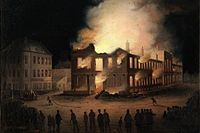Rhodeve Eglasian Dollar
The currency used in Rhodevus is called the Rhode. This comes from the full name of the currency; that being the Rhodeve Eglasian Dollar, named after the Eglasian mines where most of the silver was mined to produce coins in the 15th and 16th centuries onward until the 1880s.
Realizing the name 'Rhodeve Eglasian Dollar' was too long to say, it was nicknamed the Rhode in the late 17th century and the name stuck ever since.
Indigenous Peoples and Trade
Northern Colonies
New Capsland
The Republican Reale (1670-1735)
The Failed Revolution in Rhodevus, while a military defeat, was a monetary victory, as the colony began to establish itself with its own reserve currency. The Republican Reale began circulation in 1670 in Quiniac City, as a currency fixed to the Capslandian Cappar. The currency would enter into circulation whenever there was a shortage of coins. The only real issue, was that the Reale had no real value outside of the colony, similar to the over-stamped coins and IOUs in the Northern Colonies and New Capsland respectively.
A Republican Reale would need to be returned to a bank and exchanged for a Capslandian Cappar, in order to be used abroad. While not a new concept, the Republican Reale gained widespread popularity around the colony and was used as the predominant currency from 1690 until it was replaced with the modern currency in 1735.
From Foreign Currencies to the Rhode
The Port Joy Raid (1731)
In 1731, Pirate Queen Nina Solomon lead a massive raid on Port Joy, attacking four major banks, including the National Bank of Rhodevus. Nina and her crew made off with some 32 million NSD (1.2 billion NSD in modern currency). What she could not take back with her, she left in the banks and then set them ablaze. Not only was this a major loss of wealth, it also accounted for more than one third of all bank notes and receipts in the nation. Remaining gold was safe, but the coins and paper bills stored were all unusable.
The Rhodeve Eglasian Mines
The Eglasian Mines, located in Silver City, North Willburr (modern Wyle) had been a major source of silver since the 15th century. In 1731, following the raid, new attempts at extracting silver were made, greatly expanding the amount of silver mined. A bill was passed, allowing for a small mint to be established next to the mines to press the silver into new coins as quickly as possible in order to make up for the massive hit to the Rhodeve economy.
By 1733, the first coins were minted. By 1734, they entered into widespread circulation and in 1735 the 'Common Currency' Bill was signed into law, devaluing the Republican Reale and allowing all holders of the currency, as well as holders of all foreign currencies to replace the coinage with the new Rhodeve Eglasian coins and bills.
The Republic Coinage Act (1739)
Following the establishment of a proper currency to be used throughout the country, the Republic Coinage Act was written to establish a government controlled mint with which to create official coins and banking notes for the mainland and empire. This was accomplished through chartering banks. Chartered banks were given the right to print a set amount of bank notes per year.
Non-chartered banks were in turn forced to destroy all their reserve bank notes to ensure a standard currency throughout the nation. This act became unfavourable, especially in central Rhodevus where banks were less likely to become chartered. To keep the peace, the Republic Coinage Act was followed by the Bank Act (1741) which allowed non-chartered banks to convert a portion of their remaining reserve notes into Rhodes.
The Rhodeve Mint
The Rhodeve Mint was first established following the Republic Coinage Act of 1739. At the formal opening of the Kingstown branch of the mint on January 12, 1740, President Ivan Parcel official coin minted in Rhodevus: a 50 cent piece, bearing the effigy of President Gabriel Hopplin. The second struck was a one cent piece.
